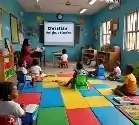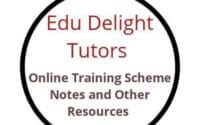My Neighbours and Neighbourhood Social Habits KG Second Term Lesson Notes Week 3
Lesson Plan on My Neighbours and Neighbourhood
Subject: Social Habits
Class: Kindergarten (Age 5)
Term: Second Term
Week: 3
Topic: My Neighbours/Neighbourhood
Sub-topic: Understanding Neighbours and Features of Our Neighbourhood
Duration: 40 Minutes
Behavioral Objectives
By the end of the lesson, pupils should be able to:
- Explain the meaning of a neighbour.
- Mention things they can see in their neighbourhood.
- Highlight the need to maintain peace with neighbours.
- Read a pictorial storybook on neighbourhood.
Keywords
- Neighbour
- Neighbourhood
- Peace
- Community
Set Induction
The teacher sings the song:
“Who are the people in your neighbourhood?
The people that you meet each day…”
The teacher asks, “Can you name someone you know in your neighbourhood?”
Entry Behaviour
Pupils have basic knowledge of their surroundings and can identify places like houses, schools, or supermarkets.
Learning Resources and Materials
- Picture charts of a neighbourhood (houses, schools, hospitals, etc.)
- Pictorial storybooks about neighbours and neighbourhoods
- Crayons for colouring activities
- Role-play props (e.g., toy houses, trees)
Building Background/Connection to Prior Knowledge
The teacher will ask pupils to recall places they have visited in their neighbourhood (e.g., the park, school, or hospital) and discuss their experiences.
Embedded Core Skills
- Creativity and Imagination: Pupils colour pictures and engage in role-play.
- Communication and Collaboration: Pupils share stories about their neighbourhoods in groups.
- Digital Literacy: Pupils watch short animations or videos about neighbourhoods.
Learning Materials
- Crayons and colouring sheets
- Charts and posters of neighbourhoods
- Pictorial storybooks
- Video clips or animations about neighbourhoods
Reference Books
- Lagos State Scheme of Work for Kindergarten
- Teacher’s guide for Social Habits
Instructional Materials
- Charts of neighbourhoods
- Toy models of houses and other community features
- Flashcards of neighbours (e.g., doctor, teacher, police officer)
Content
Definition of Neighbours and Neighbourhood
- Neighbour: A person who lives close to you.
- Neighbourhood: The area where you and your neighbours live, work, and play.
Explanation
- Neighbours help us in times of need.
- The neighbourhood has places like schools, hospitals, parks, and supermarkets.
- It’s important to maintain peace with our neighbours by being friendly and respectful.
Examples of Places in a Neighbourhood
- House: Where people live.
- School: Where children go to learn.
- Hospital: Where sick people go to get treatment.
- Supermarket: Where people buy food and other items.
- Police Station: Where police officers help keep the neighbourhood safe.
Presentation Steps
- Revision of Previous Topic:
- Teacher revises the previous topic on “Good Behaviour at Public Places” and asks pupils to recall the five magic words.
- Introduction of New Topic:
- Teacher introduces the topic by showing a chart of a neighbourhood and explaining what neighbours and neighbourhoods mean.
- Student Contributions:
- Pupils share things they have seen in their neighbourhood.
- Teacher guides corrections where necessary.
Teacher’s Activities
- Show a chart of a neighbourhood and point out different features (houses, schools, parks, etc.).
- Read a pictorial storybook about neighbours.
- Demonstrate how to relate well with neighbours through role-play.
- Encourage pupils to sing the neighbourhood song.
- Distribute colouring sheets of neighbourhood objects for pupils to colour.
Learners’ Activities
- Listen to the teacher’s explanation.
- Participate in role-playing activities.
- Sing the neighbourhood song.
- Colour pictures of neighbourhood features.
- Share stories about their neighbourhood in small groups.
Evaluation Questions
Fill-in-the-Blank Questions
- A person who lives near you is your _______.
a. Neighbour
b. Teacher
c. Doctor
d. Driver - The area where we live is called our _______.
a. Park
b. Neighbourhood
c. Hospital
d. Market - _______ is where children go to learn.
a. Hospital
b. School
c. Supermarket
d. House - _______ is where sick people go for treatment.
a. Police station
b. School
c. Hospital
d. Park - A _______ helps to keep our neighbourhood safe.
a. Doctor
b. Teacher
c. Police officer
d. Pilot - People buy things at a _______.
a. Supermarket
b. Library
c. House
d. Park - Good neighbours are _______ and kind.
a. Rude
b. Helpful
c. Noisy
d. Lazy - To keep peace, we must not _______ our neighbours.
a. Respect
b. Fight
c. Greet
d. Help - A place for play and fun in the neighbourhood is the _______.
a. Park
b. School
c. Supermarket
d. House - The area with houses, schools, and parks is our _______.
a. Market
b. Neighbourhood
c. Hospital
d. Factory
Class Activity Discussion (FAQs)
- Who is a neighbour?
- A person who lives close to you.
- What is a neighbourhood?
- The place where you and your neighbours live.
- What are some places in a neighbourhood?
- Houses, schools, hospitals, parks, supermarkets.
- Why is it important to live peacefully with neighbours?
- To make everyone happy and safe.
- What do you do when you meet a new neighbour?
- Greet them politely.
- Where do children go to learn?
- Schools.
- Where do people go to buy things?
- Supermarkets.
- Who helps keep the neighbourhood safe?
- Police officers.
- What do you say to neighbours when you need help?
- Please.
- How do you show respect to neighbours?
- By being kind and polite.
Assessment
- Write one place in your neighbourhood.
- Who is a neighbour?
- Write one good behaviour in a neighbourhood.
- Where do people go to get treatment?
- Why is it good to keep peace with our neighbours?
- Name one place where people buy things.
- What do you say when you borrow something?
- Who teaches children at school?
- Write one place for fun in a neighbourhood.
- What is a neighbourhood?
Conclusion
The teacher marks pupils’ work, corrects errors, and praises their efforts. The pupils sing the neighbourhood song again to reinforce learning.
SEO Elements
- Captivating Title: Fun Lesson on My Neighbourhood for Kindergarten
- Focus Keyphrase: My Neighbours and Neighbourhood
- SEO Title: Engaging Lesson on Neighbours and Neighbourhood for Kids
- Slug: my-neighbours-neighbourhood-kindergarten
- Meta Description: Discover a fun and interactive lesson plan on neighbours and neighbourhoods
- Back to School and Revision Social Habits KG Second Term Lesson Notes Week 1
- Good Behaviour in Public Places Social Habits KG Second Term Lesson Notes Week 2
Related
Related posts:
- Back to School and Revision Social Habits KG Second Term Lesson Notes Week 1
- Occupations Social Habits KG Second Term Lesson Notes Week 8
- Hair Care Social Habits KG Second Term Lesson Notes Week 9
- Respecting Others Social Habits KG Second Term Lesson Notes Week 10
- Second Term Mid-Term Assessment Social Habits KG Second Term Lesson Notes Week 6
Related Posts

Good Eating Habits Health Habits Kindergarten Second Term Lesson Notes Week 7

Joseph and His Brothers Christian Religious Studies Kindergarten First Term Lesson Notes Week 4

Correct Sitting Posture Physical Development Kindergarten Second Term Lesson Notes Week 2
About The Author
Edu Delight Tutors
Am a dedicated educator with a passion for learning and a keen interest in technology. I believe that technology can revolutionize education and am committed to creating an online hub of knowledge, inspiration, and growth for both educators and students. Welcome to Edu Delight Tutors, where learning knows no boundaries.